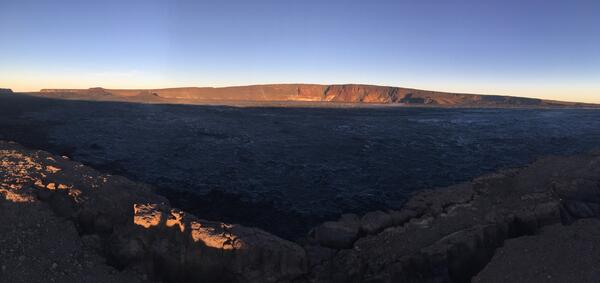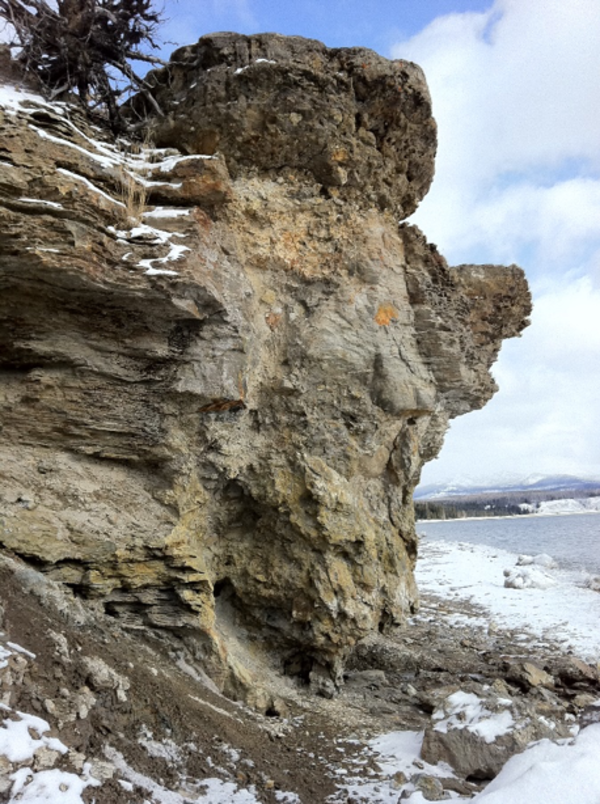USGS scientists collect gas from the Puhimau thermal area on Chain of Craters Road in Hawai‘i Volcanoes National Park. The gas is collected in evacuated (vacuum-pumped so that no gas at all is inside) glass bottles, and a system of a syringe with tubing helped ensure minimal contamination by ambient atmospheric gases.
Images
Volcano Hazard Program images.

USGS scientists collect gas from the Puhimau thermal area on Chain of Craters Road in Hawai‘i Volcanoes National Park. The gas is collected in evacuated (vacuum-pumped so that no gas at all is inside) glass bottles, and a system of a syringe with tubing helped ensure minimal contamination by ambient atmospheric gases.

Puhimau thermal area has the largest naturally occurring population of the endangered plant, Portulaca sclerocarpa (marked by the blue flag in the photo), and is the site of National Park Service restoration efforts for this species.
Puhimau thermal area has the largest naturally occurring population of the endangered plant, Portulaca sclerocarpa (marked by the blue flag in the photo), and is the site of National Park Service restoration efforts for this species.

The Field trip guide to Mount St. Helens, Washington—Recent and ancient volcaniclastic processes and deposits is available in the USGS Publications Warehouse, at https://doi.org/10.3133/sir20175022E.
The Field trip guide to Mount St. Helens, Washington—Recent and ancient volcaniclastic processes and deposits is available in the USGS Publications Warehouse, at https://doi.org/10.3133/sir20175022E.
Geophysicist Sarah Conway, a member of the USGS Hawaiian Volcano Observatory's deformation team, readies a temporary GPS station during a campaign survey of benchmarks on Kīlauea Volcano to monitor changes in the ground surface.
Geophysicist Sarah Conway, a member of the USGS Hawaiian Volcano Observatory's deformation team, readies a temporary GPS station during a campaign survey of benchmarks on Kīlauea Volcano to monitor changes in the ground surface.

USGS Hawaiian Volcano Observatory and DOI Office of Aviation staff prepare the sampling mechanism (on blue tarp) and inspect the Unmanned Aircraft System (UAS) just before it took off to collect water from the Halema‘uma‘u crater lake. Brightly-colored flagging tape tied to a cable attached to the UAS indicated depth as the sampling tool was lowered into the water.
USGS Hawaiian Volcano Observatory and DOI Office of Aviation staff prepare the sampling mechanism (on blue tarp) and inspect the Unmanned Aircraft System (UAS) just before it took off to collect water from the Halema‘uma‘u crater lake. Brightly-colored flagging tape tied to a cable attached to the UAS indicated depth as the sampling tool was lowered into the water.

Water collected from the lake at the bottom of Halema‘uma‘u is prepared for laboratory analyses at the USGS California Volcano Observatory. Results thus far reveal chemistry indicative of complex reactions between the water, magmatic gases, and Kīlauea's basaltic rocks. USGS photo by S. Peek, October 2019.
Water collected from the lake at the bottom of Halema‘uma‘u is prepared for laboratory analyses at the USGS California Volcano Observatory. Results thus far reveal chemistry indicative of complex reactions between the water, magmatic gases, and Kīlauea's basaltic rocks. USGS photo by S. Peek, October 2019.

The "Short-term Sulfur Dioxide Advisory Level Information" table (http://www.hiso2index.info/assets/FinalSO2Exposurelevels.pdf) uses a six-tiered color-coded system to depict sulfur dioxide (SO2) concentrations and provide guidance for different groups of people exposed to SO2.
The "Short-term Sulfur Dioxide Advisory Level Information" table (http://www.hiso2index.info/assets/FinalSO2Exposurelevels.pdf) uses a six-tiered color-coded system to depict sulfur dioxide (SO2) concentrations and provide guidance for different groups of people exposed to SO2.
Two HVO geologists document road cutting activities on HWY 132 on August 7, 2019. One geologist is taking visual photographs while another geologist is taking thermal photographs to make a tandem pair for comparison. The temperature of the solidified lava was measured to 425 ° C (800 ° F) at the digging site. Photograph by USGS geologist K.
Two HVO geologists document road cutting activities on HWY 132 on August 7, 2019. One geologist is taking visual photographs while another geologist is taking thermal photographs to make a tandem pair for comparison. The temperature of the solidified lava was measured to 425 ° C (800 ° F) at the digging site. Photograph by USGS geologist K.

Still image from November 1, 2019, YVO video monthly update.
Still image from November 1, 2019, YVO video monthly update.
Transportation takes many forms; this horse trek to GPS station HVWY in Hayden Valley complies with wilderness regulations, reduces impact to sensitive areas, and enables teams to upgrade equipment to keep the site operational year-round. Site maintenance was completed under permit YELL-2019-SCI-5546, in close coordination with Park staff, on September 18, 2019.
Transportation takes many forms; this horse trek to GPS station HVWY in Hayden Valley complies with wilderness regulations, reduces impact to sensitive areas, and enables teams to upgrade equipment to keep the site operational year-round. Site maintenance was completed under permit YELL-2019-SCI-5546, in close coordination with Park staff, on September 18, 2019.

Map of monitoring instruments in and around Yellowstone National Park as of October 31, 2019. To view the interactive version of this map, go to the Yellowstone Volcano Observatory website.
Map of monitoring instruments in and around Yellowstone National Park as of October 31, 2019. To view the interactive version of this map, go to the Yellowstone Volcano Observatory website.

This video shows the unmanned aerial system collecting a water sample from Halema‘uma‘u. This wider view shows the scale of the UAS relative to the water pond. USGS video by M. Patrick, 26 Oct 2019.
This video shows the unmanned aerial system collecting a water sample from Halema‘uma‘u. This wider view shows the scale of the UAS relative to the water pond. USGS video by M. Patrick, 26 Oct 2019.

This video shows a close-up of the unmanned aerial system collecting a water sample in Halema‘uma‘u. USGS video by M. Patrick, 26 Oct 2019.
This video shows a close-up of the unmanned aerial system collecting a water sample in Halema‘uma‘u. USGS video by M. Patrick, 26 Oct 2019.
USGS and OAS team prepares the sampling mechanism and inspects the unmanned aerial system a few minutes before mission start and takeoff. All safety precautions were taken to ensure the aircraft and sampling mechanism were sterile, and would return safely from the pond.
USGS and OAS team prepares the sampling mechanism and inspects the unmanned aerial system a few minutes before mission start and takeoff. All safety precautions were taken to ensure the aircraft and sampling mechanism were sterile, and would return safely from the pond.

Civil Air Patrol captured this aerial image of Mauna Loa's summit caldera, Moku‘āweoweo, on Sunday, October 20, 2019. The true summit of Mauna Loa is located just to the right of the center of the image, at the highest location above the caldera wall in the background.
Civil Air Patrol captured this aerial image of Mauna Loa's summit caldera, Moku‘āweoweo, on Sunday, October 20, 2019. The true summit of Mauna Loa is located just to the right of the center of the image, at the highest location above the caldera wall in the background.

An early morning view looking north across Moku‘āweoweo, Mauna Loa's summit caldera, from a spot near the summit cabin on the volcano's south caldera rim. Frost covered much of the caldera floor that was still shadowed, and weak steaming issued from the usual areas. Overall, there were no significant changes observed at the summit.
An early morning view looking north across Moku‘āweoweo, Mauna Loa's summit caldera, from a spot near the summit cabin on the volcano's south caldera rim. Frost covered much of the caldera floor that was still shadowed, and weak steaming issued from the usual areas. Overall, there were no significant changes observed at the summit.
Sulphur Cone (left), viewed toward southwest, from 3,480 m (11,420 ft) above sea level on Mauna Loa's southwest rift zone. At right, an HVO geoscientist and technician rebuild volcanic gas monitoring equipment installed near an outgassing fissure.
Sulphur Cone (left), viewed toward southwest, from 3,480 m (11,420 ft) above sea level on Mauna Loa's southwest rift zone. At right, an HVO geoscientist and technician rebuild volcanic gas monitoring equipment installed near an outgassing fissure.

The water level at Kīlauea summit continues to slowly rise, with the size of the pond gradually enlarging. The pond today was at least 140 m (460 ft) in the east-west direction (from bottom to top of image). This length is a minimum estimate as the west end of the pond is now partially blocked from view by the crater walls. USGS photo by D. Swanson.
The water level at Kīlauea summit continues to slowly rise, with the size of the pond gradually enlarging. The pond today was at least 140 m (460 ft) in the east-west direction (from bottom to top of image). This length is a minimum estimate as the west end of the pond is now partially blocked from view by the crater walls. USGS photo by D. Swanson.

Black Dog breccia pipe is the remnant of an inactive hydrothermal vent system fo
Black Dog breccia pipe is the remnant of an inactive hydrothermal vent system fo

Material filling the dissolved voids includes clasts of wall rock as well as beach sediments being washed into the voids. The lower structure on the left is about 0.7 m (2 ft) wide and 1.5 m (5 ft) high. Note the fracture alignment above the void structure on the right.
Material filling the dissolved voids includes clasts of wall rock as well as beach sediments being washed into the voids. The lower structure on the left is about 0.7 m (2 ft) wide and 1.5 m (5 ft) high. Note the fracture alignment above the void structure on the right.

A closer look at the water surface. While most of the surface has a yellow-green color, portions along the shoreline have a blue color and seem to correspond to areas of water upwelling. USGS photo by M. Patrick.
A closer look at the water surface. While most of the surface has a yellow-green color, portions along the shoreline have a blue color and seem to correspond to areas of water upwelling. USGS photo by M. Patrick.






